A century ago in World War I, six soldiers from Chandler were killed on the same day. A retired local judge has decided it’s time that story was told...

Only the names on the telegrams were different.
Otherwise, the six were exactly the same: Same date. Same place. Even the same wording.
“It must’ve been gut-wrenching,” said Paul Vassar, who still has a hard time grasping what it was like for his hometown — losing six of its young men on the same day in World War I.
“Chandler was an even smaller community then, where all the families knew each other,” he said.
Although the deaths occurred on Oct. 8, 1918, it was three weeks before the news arrived in Chandler and telegrams were sent to the families.
Making the loss even harder to swallow, just a week later that same telegraph relayed another big news item: An armistice had been signed. The war was over.
“How terribly bittersweet that must’ve been,” Vassar said.

A retired district judge for Lincoln and Pottawatomie counties, Vassar has written a book about this tragic chapter in his hometown’s history. It’s called “The Boys: The Story of a Town and War.”
The men were part of a Chandler-area National Guard unit sent to France to fight.
“Sadly, the story was lost to time,” Vassar said. “I wasn’t aware of most of it until I started researching.”
Vassar’s first vague awareness of the story came as a boy in Chandler, where he attended First United Methodist Church.
At the church, which is still there, are two stained-glass windows dedicated to Lt. Arthur Matheny and Sgt. Charlie Bouse.
The pair, who had ties to the church, were among the six guardsmen slain in 1918.
Vassar recalls pondering the windows as a boy, but it would be a long time before he learned more — that the two men had died on the same day, along with four others from the town.
Members of the local National Guard unit were known around town as “The Boys,” Vassar said, adding they were all friends.
In 1917, with the U.S. entry into WWI, the unit was called to federal service, and with other Oklahoma and Texas guards formed the new 142nd Infantry Regiment. The Chandler “Boys” were made part of the unit’s Company B.
The fateful day would come many months later near the village of St.-Etienne-a-Arnes in France.
Company B, which numbered 150 members, suffered 32 casualties in the fighting of Oct. 8, 1918, including 13 killed.
Among them from Chandler were Matheny, Bouse, Forest Cox, Ulus Dunn, Samuel Pidcock and Cleason Dale.

That the deaths were so unnecessary is hard to take.
“The disgusting thing is that peace talks were already going on at the time,” Vassar said, adding that the battle accomplished nothing.
But while it was a tragic day, he said, it was also a day of heroism.
Vassar especially enjoys telling the story of Lee Gilstrap.
Gilstrap, 15, of Chandler had lied about his age to join the unit and go overseas.
“His father, Harry, was the company commander. So I’m not sure how the lying thing worked,” Vassar chuckled.
At one point on the day of the battle, Gilstrap decided to grab a stretcher and run to the aid of fallen comrades under fire.
What started as a rash move turned into something much more.
After nearly being killed when a bullet ricocheted off his helmet, Gilstrap grabbed a rifle at hand and before he was done, had singlehandedly captured several of the enemy.
Gilstrap would receive a Distinguished Service Cross and Silver Star for his actions.
Chandler had a population of around 2,500 at the time of the war.
As one local newspaper put it, the news of the deaths cast “a pall of gloom (over the town) — every citizen, man, woman, and child grieve with the stricken ones … broken-hearted wives, mothers, fathers, brothers and sisters.”
The surviving troops arrived home the following summer. As sad as many townsfolk still were over the deaths, they celebrated.
It would be 1921 before the remains of those slain were returned. Five are buried at Oak Park Cemetery there, another at Fort Gibson National Cemetery.
Since he began researching the book, Vassar has twice visited St.-Etienne.
He couldn’t help thinking, he said, “what a long way the Boys had come to die.”
Vassar was both surprised and touched, he said, to find that a church there honors two fallen French soldiers in the same way as First Methodist: with commemorative stained-glass windows.
Vassar was district judge from 1995 to 2010. Although officially retired, he keeps an office in Chandler across the street from the Lincoln County Courthouse.
It was after he retired that Vassar’s wife suggested he write about the town’s history for the local paper.
“There’s no way a lawyer can say anything in 1,500 words,” he joked, adding that it quickly turned into a book-length project.
When his initial efforts read more like the legal briefs and opinions he used to write, he told himself to “just tell the story.”
Vassar’s book starts with Chandler’s founding and details its early years, including it being wiped out by a tornado in 1897 and other events, leading up to WWI.
Vassar said he marvels at the courage of those early townsfolk.
“It took courage to come here in 1891, took courage to stay and build the community.”
And it would take courage for the surviving families of the soldiers to carry on.
It’s that history of resilience that makes Vassar proud to be from Chandler.
“My roots are deep in the red dirt of this place,” he said.
(Source: Tim Stanley, Tulsa World-11/8/2019)































